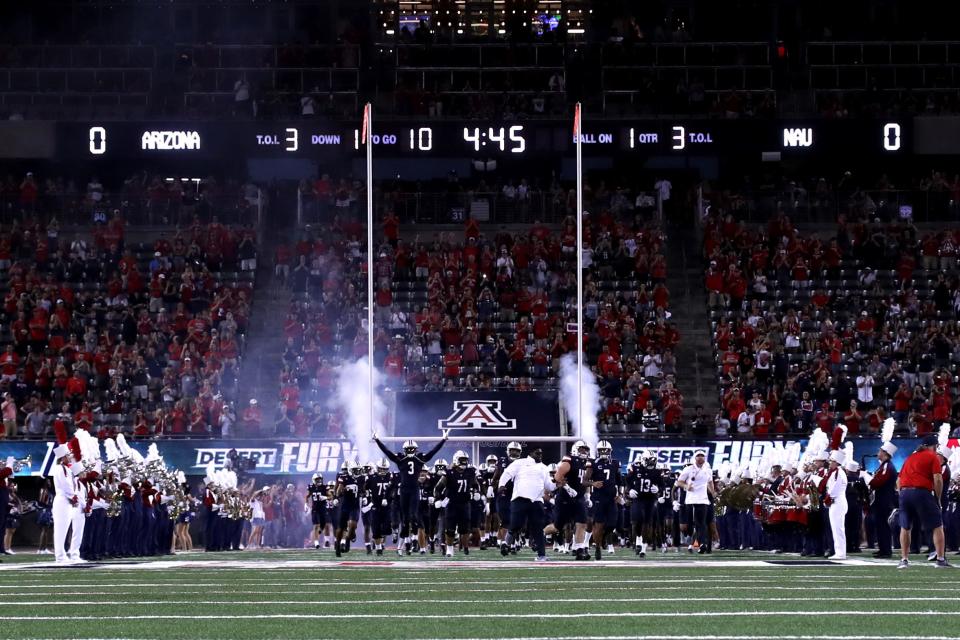College football conference shakeups could almost double carbon emissions, study finds
Recent realignments in college football conferences could affect more than just the time you sit down to watch your favorite team.
A team of researchers at Arizona State University estimates that the reconfiguration of the five major college athletic conferences will likely result in nearly twice the carbon emissions as those teams are forced to travel farther than ever to play.
“We’ve never had such a massive, massive realignment in terms of distances,” said Ross Maciejewski, a computer science professor at ASU and the study’s supervisor.
As conferences expand, member schools must cover greater distances to play each other. Instead of traveling up and down the West Coast, ASU and the University of Arizona will fly as far as Florida and West Virginia.
This means a likely increase in carbon emissions produced by the airplanes and buses teams use to travel.

Carbon dioxide, or CO2, is a greenhouse gas emitted primarily through the burning of fossil fuels. It’s the main greenhouse gas produced through human activities and is credited as one of the primary drivers of human-caused climate change.
According to the ASU study, “Carbon Emissions in Football Games,” all but one conference in the Power Five will see an increase in emissions, and emissions could increase almost twofold across the five.
The Atlantic Coast Conference (ACC) will likely more than double its emissions per game. The Big Ten’s emissions will also double and the Big 12 will see a 23% increase in emissions. The SEC’s emissions will only slightly increase.
The only conference that did not see an increase was the Pac-12, which is currently a two-team conference after losing 10 of its 12 members, including ASU and the UA, to other conferences.
The study only estimates the carbon impacts of team travel and does not account for the cross-country trips fans might be willing to take to see their team play, which could increase emissions even further.
Conference shakeups redraw the field
In the early 2010s, conferences in the Power Five were organized by region. The ACC covered the eastern seaboard, stretching from the University of Miami to Boston College. The Big Ten mostly covered the midwest, and the Pac-12 organized teams in the western U.S., with schools including ASU and the UA and others along the west coast.
But the prospect of larger television contracts motivated teams to pursue more “desirable” conferences.
Now, four of the Power Five conferences are facing greater travel distances as new members stretch the borders of the conferences.
ASU and the UA will leave the Pac-12 to join the Big 12, increasing the average travel distance of that conference by over 200 miles, and the Atlantic Coast Conference, or ACC will now stretch all the way to the West Coast with the inclusion of Stanford and the University of California, Berkeley.
“Instead of the Atlantic Coast Conference, you’re the All Coast Conference,” Maciejewski said.
This means teams will have to travel farther to play teams within their conferences, increasing the amount of carbon dioxide emitted by planes and buses.
While conference realignment in the past year has drastically increased the distances between teams, emissions have been increasing for years, according to the research.
“Even before last year … we can still improve the carbon emission situation,” said Jiayi Hong, a postdoctoral researcher who worked on the paper.

The recent shakeup marks a much more significant increase.
“It’s pretty obvious to anybody that the miles being traveled by these students increased drastically overnight,” Maciejewski said.
Counting the yards to travel touch down
To estimate emissions, researchers collected matchups from team schedules spanning from 2010 up to games planned for the upcoming 2024 season, said Sia Sheguri, an ASU student who worked on the study.
The team plugged the distance between schools into a formula that includes how much CO2 is emitted per passenger on trips to and from an away team’s stadium. Researchers considered plane flights for longer trips and bus rides for shorter distances.
The results show every conference except the Pac-12 will see an increase in carbon emissions per game. Carbon emissions from the Pac-12 are hard to determine since the conference will be made up of just two teams come August.
“We just sort of had to punt there and say we don’t know what the Pac-12 will look like in the future,” Maciejewski said.
Researchers will continue to study emissions patterns of the conference and will look into how conferences could best be organized to minimize emissions.
This article originally appeared on Arizona Republic: College football shakeups could increase CO2 emissions


